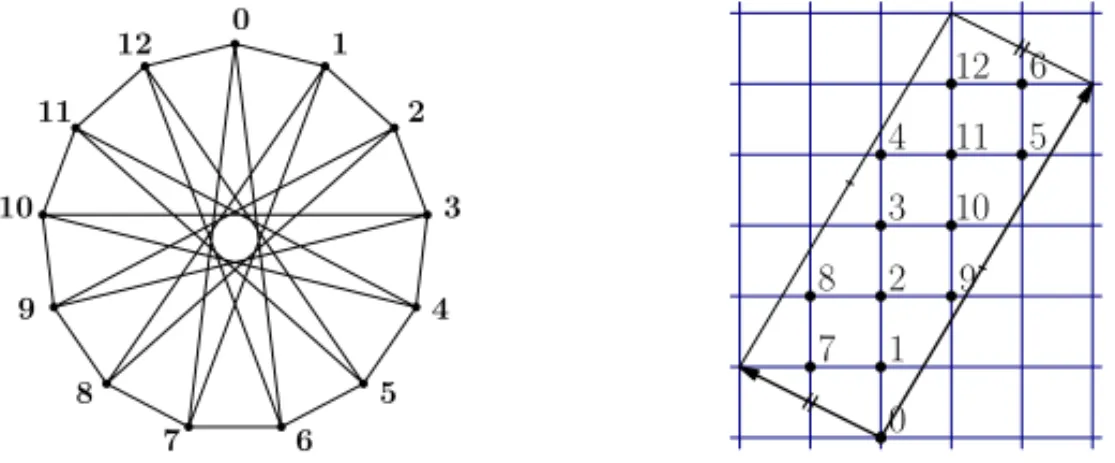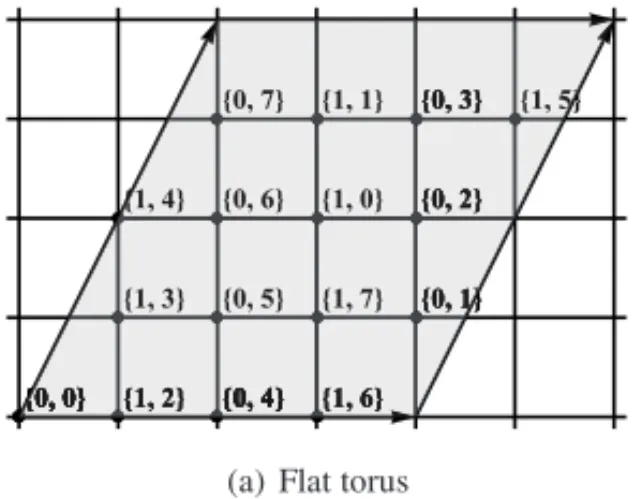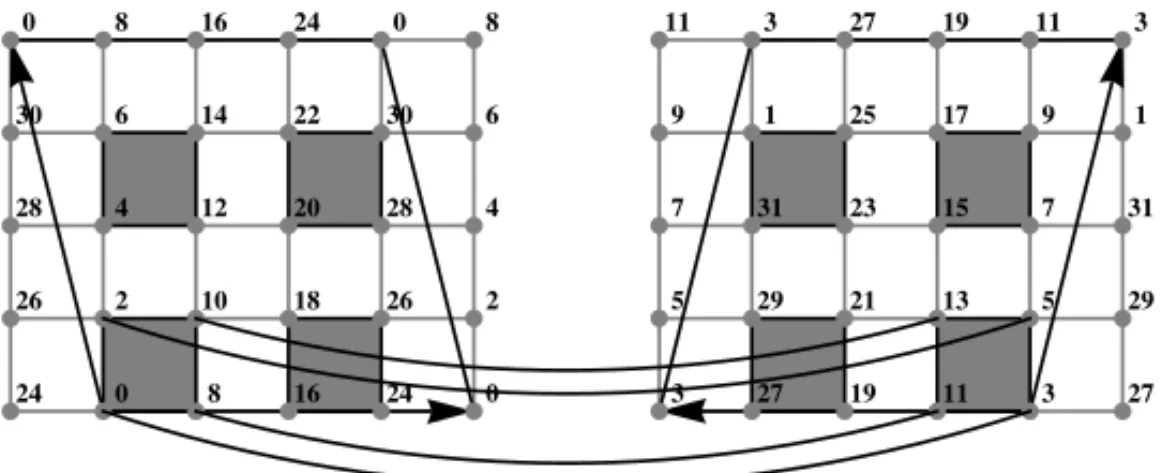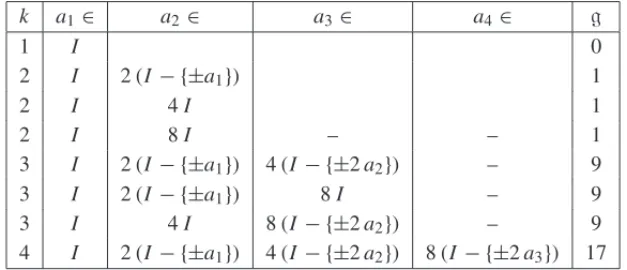A Note on Quadrangular Embedding of Abelian Cayley Graphs
J.E. STRAPASSON1*, S.I.R. COSTA2 and M. MUNIZ3
Received on January 03, 2016 / Accepted on October 21, 2016
ABSTRACT.The genus graphs have been studied by many authors, but just a few results concerning in special cases: Planar, Toroidal, Complete, Bipartite and Cartesian Product of Bipartite. We present here a general lower bound for the genus of a abelian Cayley graph and construct a family of circulant graphs which reach this bound.
Keywords:Abelian Cayley Graphs, Genus of a graph, Flat torus, Tessellations.
1 INTRODUCTION
The genus of a graph, defined as the minimum genus of a 2-dimensional surface4on which this graph can be embedded without crossings ([7, 21]), is well known as being an important measure of the graph complexity and it is related to other invariants.
A circulant graph,Cn(a1, . . . ,ak),is an homogeneous graph which can be represented (with crossings) bynvertices ({v0, . . . vn−1}) on a circle, with two vertices being connected if only if there is jump ofai from one to the other,∀i = 1, . . . ,k, where a jump is an edge betweenvj andvmod(j±ai,n) (Figure 1). A circulant graph is particular case of abelian Cayley graph. Different aspects of circulant graphs have been studied lately, either theoretically or through their applications in telecommunication networks and distributed computation [10, 12, 11, 15, 13, 9].
Concerning specifically to the genus of circulant graphs few results are known up to now. We quote [3] for a small class of toroidal (genus one) circulant graphs, [9] which establish a complete classification of planar circulant graphs, [5] which establish a complete classification of minimum genus 1 and 2 for circulant graphs, and the cases where the circulant graph is either complete or a bipartite complete graph ([4, 8, 17, 18, 20]).
*Corresponding author: Jo˜ao Eloir Strapasson.
1Faculdade de Ciˆencias Aplicadas, Unicamp – Universidade de Campinas, 13484-350 Limeira, SP, Brasil. E-mail: joao.strapasson@fca.unicamp.br
2Departamento de Matem´atica, Unicamp – Universidade Estadual de Campinas, 13083-970 Campinas, SP, Brasil. E-mail: sueli@ime.unicamp.br
3Departamento de Matem´atica, UFPr – Universidade Federal do Paran´a, 81531-980 Curitiba, PR, Brasil. E-mail: marcelomsa@ufpr.br
In [6] the authors show how any circulant graph can be viewed as a quotient of lattices and obtain as consequences that: i) fork =2, any circulant graph must be either genus one or zero (planar graph) and ii) fork=3, there are circulant graphs of arbitrarily high genus.
We derive a general lower bound for the genus of abelian Cayley graphCn(a1, . . . ,ak)as
(k−2)n+4 4 (Proposition 1), and construct a family of abelian Cayley graphs which reach this bound (Corollary 4).
This note is organized as follows. In Section 2 we introduce concepts and previous results concerning circulant graphs, abelian Cayley graphs and genus.
In Section 3 we derive a lower bound for the genus of ann-circulant graph of order 2k(Proposition 1) and construct families of graphs reaching this bound for arbitrarilyk(Corollary 4).
2 NOTATION AND PREVIOUS RESULTS
In this section we recall concepts and results used in this paper concerning circulant graphs. We also fix the notations which will be followed later on.
Let G = ({e = g1, . . .gn},+) be a finite abelian group. Given a subsetS = {a1, . . . ,ak}of G, the associatedCayley graph(G,S)is an undirected graph whose vertices are the elements ofG, and where two verticesgiandgj are connected if and only ifgi −gj = ±al for someal ∈ S. We remark that(G,S)is connected if and only ifSgeneratesGas a group, and that this graph is 2k-regular ifai+ai =0,∀i = 1,2, . . .k,and(2k−l)-regular otherwise, wherelis a number ofaisuch thatai+ai=0.
Acirculant graph Cn(a1, . . . ,ak)withnverticesv0, . . . vn−1 and jumpsa1, . . . ,ak, 0 < aj ⌊n/2⌋,
ai =aj, is an undirected graph such that each vertexvj,0 j n−1, is adjacent to all the vertices vj±ai modn, for 1ik. A circulant graph is homogeneous: any vertex has the same degree (number of incident edges), with is 2kexcept whenaj = n2 for some j, when the degree is 2k−1, a circulant graph is a particular case of abelian Cayley graph(G=Zn,S= {a1, . . . ,ak}).
The n-cyclic graph and the complete graph of nvertices are examples of circulant graphs denoted by Cn(1)andCn(1, . . . ,⌊n/2⌋), respectively. Figure 1 shows on the left the standard picture of the circulant graphC13(1,6).
0 1
2
3
4
5
6 7 8 9 10
11 12
0 1 2 3
4 5
6
7
8 9
10 11 12
Figure 1: The circulant graphC13(1,6)represented in the standard form (left) and on a
In what follows we write(a1, . . . ,ak)= (a˜1, . . . ,a˜k) modnto indicate that for eachi, there is jsuch thatai = ±˜aj modn. Two circulant graphs,Cn(a1, . . . ,ak)andCn(a˜1, . . . ,a˜k)are said to satisfy the
´
Ad´am’s relationif there isr, with gcd(r,n)=1, such that
(a1, . . . ,ak)=r(a˜1, . . . ,a˜k) modn (1)
An important result concerning circulant graphs isomorphisms is that circulant graphs satisfying the ´Ad´am’s relation are isomorphic ([1]). The reciprocal of this statement was also conjectured by ´Ad´am. It is false for general circulant graphs but it is true in special cases such ask=2 orn= porn= pq(pandqprime) (see [11, 2]). In this paper we will not distinguish between isomorphic graphs.
Without loss of generality we will always consider a1 < · · · < ak n/2 for a circulant graph Cn(a1, . . . ,ak).
A circulant graphCn(a1, . . . ,ak)is connected if, and only if, gcd(a1, . . . ,ak,n)= 1 ([3]).In this paper
we just consider connected circulant graphs.
The genus of a graph is defined as the minimum genus,ᒄ, of a 2-dimensional orientable compact surface Mᒄon which this graph can be embedded without crossings ([7, 21]). This number, besides being a measure of the graph complexity, is related to other invariants. LetGa graph of the genusᒄ, defines pᒄas pᒄ = (7
+√48ᒄ+1) 2
, so: thechromatic numberofGisγ (G) = pᒄ(Heawood conjecture) and thealgebraic
connectivity5ofG,µ(G), , satisfiesµ(G) <pᒄ−1 for all noncomplete graphsGifpᒄ(pᒄ−7)=12(ᒄ−1),
see [14].
A graphEis asubdivisionof Hif it is constructed from Hby possibly adding new vertices on the edges ofH. Finally, if there is a subdivisionEof Hwhich is a subgraph ofGwe sayGissupergraphofH. From this definition follows that
if G is a supergraph of H , genus(G)genus(H ).
When a connected graphGis embedded on a surface,M
ᒄ, of minimum genusᒄit splits the surface in regions calledfaces, each one homeomorphic to an open disc surrounded by the graph edges, giving rise to a tessellation on this surface. Denoting the number of faces, edges and vertices by f,e, andvrespectively, those numbers must satisfy the well known Euler’s second relation:
v+ f−e=2−2ᒄ (2)
We quote next other known relations those numbers must satisfy ([7, 21]):
IfGis a graph of genusᒄwithvlsuch that any face inMᒄhas at leastlsides in its boundary,
l f 2e and ᒄl−2
2l e− 1
2(v−2). (3)
In the above expressions we have equalities if, only if, all the faces havelsides.
An upper bound for the genus of a connected graph ofnvertices is given by the genus of thecomplete
graph,Cn(1, . . . ,⌊n/2⌋), which is
(n−3)(n−4) 12
. Combining the lower bound above with a minimum of three edges for each face, we can write the following inequality, forn3:
1 6e−
1 2(n−2)
ᒄ
(n−3)(n−4) 12
, (4)
where⌈x⌉is the ceiling (smallest integer which is greater or equal to) ofx.
For a circulant graphCn(a1, . . . ,ak),a1<a2<· · ·<akwe can replaceebye=n kwhenak < n2, or
e=n(2k−1)/2 whenak= n2. We can then rewrite the lower bound in last expression asn6(k−3)+1 orn
6(k−4)+1 , respectively.
2.1 Previous results on genus of circulant graphs and abelian Cayley graphs
• Theorem(Ringel, Beineke and Harary, 1965 [19, 4]). The genus of the n-cube graph Qn is1+ 2n−3(n−4).
• Theorem(Ringel, 1965 [17, 18]). The genus of the complete bipartite graph Km,nis
(m
−2)(n−2) 4
.
SinceKn,nis the circulant graphC2n(1,3, . . . ,2
n−1
2
−1), the genus of this one-parameter family
is
(n−2)2 4
.
• Theorem(White, 1970 [22]). Let G =Cm1Cm2· · ·Cmr6, where Cmi is even cycle, r >1and
mi >3for all i . Then the genus of G is1+v(r−2)/4, wherev=m1m2,· · ·mr.
• Theorem(Pisanski, 1980 [16]) Let G and H be connected r -regular bipartites graphs. Then the
Cartesian product GH of G and H has genus1+pm(r−2)/4where p and m are the number of
vertices of G and H , respectively.
• Theorem(Heuberger, 2003 [9]). A planar circulant graph is either the graph Cn(1), or Cn(a1,a2),
where i) a2= ±2a1 modn and n is even, ii) a2=n/2, and a2is even.
• Fork =2,and general(a1,a2),we have shown that circulant graphsCn(a1,a2)are very far for from reaching the upper bound for the genus given in (4), as it was shown in [6]:
Proposition 1 ([6]).Any circulant graph Cn(a1,a2), a1<a2n/2, has genus one, except for
the cases of planar graphs: i) a2= ±2a1 modn,and n is even, ii) a2=n/2, and a2is even.
• Fork=3 andn=2a3we can assert that the genus ofCn(a1,a2,a3)satisfies:
1ᒄ
(n
−3)(n−4) 12
(5)
The genus of the complete graphC7(1,2,3)achieves the minimum value one (4). However, in opposition to the casek=2, the genus of a circulant graphCn(a1,a2,a3)can be arbitrarily high:
Proposition 2 ([6]).There are circulant graphs Cn(a1,a2,a3)of arbitrarily high genus. A family
of such graphs is given by: n=(2m+1) (2m+2) (2m+3), m2;a1=(2m+2) (2m+3),
a2=(2m+1)(2m+2) (m+1),a3=(2m+2) (2m+3) (m+1),with the correspondent genus
satisfying
ᒄ2m(m+1)2+1. (6)
In the next section we deal with the more general class of abelian Cayley graphs and establish a lower bound for their genus.
6The Cartesian productG
3 QUADRANGULAR EMBEDDING OF ABELIAN CAYLEY GRAPHS
In this section we consider Cayley graphs of abelian groups, a more general class of graphs of which circu-lant graphs form a very particular subclass, the Cayley graphs of cyclic groups. Nevertheless, an important feature of circulant graphs, their embeddings ink-dimensional tori, is shared by the whole class of Cayley graphs of abelian groups. We will see in the following thatk is associated to the number of elements of the generating set of the edges of the Cayley graph. We will determine a subclass of these graphs that has quadrangular embeddings, and hence a subclass where we know the genus of each graph.
It is known that graphs that have 3-cycles may have embeddings with triangular faces, and some easy calculations establish a lower bound for the genus. In general we can also establish a lower bound that depends on the girthl of the graph. If (G,S)is a Cayley graph and there are no solutions of ah = ±(ai ±aj)forh,i,j ∈ {1,2, . . .k}(not necessarily distinct), the girth is always 4 (a typical 4-cycle is 0,ai,ai+aj,aj,0), which implies at least four edges for each face.
If the graph is 2k-regular, then
ᒄl−2
2l a−
v−2
2 =
2 8n k−
n−2
2 =
n k−2n+4
4 .
Hence, we get the following lemma, which establishes a lower bound for circulant graphs with no triangular faces.
Lemma 1.The genus,ᒄ, of the circulant graph Cn(a1, . . . ,ak),such that ai=aj+al, ∀i,j,lk and
n=2ai, ∀i satisfy:
ᒄ n k−2n+4
4 .
In what follows the (additive) subgroup ofG=Zn1×Zn2 × · · · ×Znl generated bya1, . . . ,ak ∈Gis denoted bya1, . . . ,ak, and letGs = a1,a2, . . . ,as ⊳G. DefineLsas the group order ofas, 1sk, whereL1= o(a1)is the group order ofa1, andLs =o(as +Gs−1)= [Gs :Gs−1]is the index of the quotient group 1<sk.
Under the above conditions we can assert thatx ∈ Gcan be expressed uniquely as a linear combination, x=m1a1+m2a2+. . .mkak, where 0mi <Li. This fact is stated in the next a lemma.
Lemma 2.Given x∈G and Gs⊳G,1s<k then there exist a unique mi ∈Nand Rs,x such that
x=m1a1+ · · · +msas+Rs,xand Rs,x =R(ms+1, . . . ,mk)=ms+1as+1+ · · ·mkak
with0mi <Lifor all i .
Through the Lemma 2 we can show that not only the circulant graphs [6] but any Cayley graph of an abelian group can be embedded in ak-dimensional torus. The construction of such embedding, fork=2, is illustrade in Figure 2.
We consider the mapping:
ϕ: Zk −→ G
(x1, . . . ,xk) −→ x1a1+ · · ·xkak.
Therefore Z k
kerϕ ≃ Gand kerϕis lattice. The Cayley graph associated toG, as a quotient of lattices, is then naturally embedded in flat torus which a polytope generated by basis of this lattice, with the parallel faces identified.
To proceed in a uniform way we can use the standard Hermite basis for kerϕ, as it done for circulant graphs in [9].
We remark that Hermite basis of kerϕ, {U1, . . . ,Uk}, is given as columns of a upper triangular matrix (bi,j)k×k, wherebi,i =Liand 0bi,j <Li.
In Figure 2, we consider the Cayley graph ofG= Z2×Z8anda1= (1,2)anda2 =(0,1), therefore
o(a1)=4 ando(a2+ a1)=4 and Hermite basis is{(4,0), (2,4)}.
80, 0<
80, 1< 80, 2< 80, 3<
80, 4< 81, 2< 81, 3< 81, 4<
81, 5<
81, 6< 80, 4< 80, 5< 80, 6< 80, 7<
80, 0< 81, 6<
81, 7< 81, 0< 81, 1<
81, 2< 80, 0<
80, 1< 80, 2< 80, 3<
80, 4<
81, 3< 81, 4<
81, 5<
80, 5< 80, 6< 80, 7<
8811,, 66<< 81, 7< 81, 0< 81, 1<
8811,, 22<< 88880000,,,, 0000<<<<
8800,, 11<< 8800,, 22<< 8800,, 33<<
88880000,,,, 4444<<<<
(a) Flat torus (b) Torus
Figure 2: 2-embedding of Cayley graph(Z2×Z8,{(1,2), (0,1)}).
We will construct the embedding of Cayley graphs(G,S)by induction onk = #S(#Sis equal to the cardinality ofS). Note that(G,S− {ak})may be disconnected: it is well known that this graph hasd = gcd(n,a1, . . . ,ak−1)components, where Lk = [G = Gk : Gk−1] = o(ak+ Gk−1), and that each component is isomorphic to the Cayley graph(Gk−1,S− {ak}). Sincexandyare linked by a path if and only ifx−y=m1a1+ · · · +mk−1ak−1inG, it follows thatxandyare in the same component if and only ifx ≡y∈Gk−1. Hence, each 0 js <Lkdetermines a component and the numbers,
Rk,mk +m1a1+ · · · +mk−1ak−1
describe all vertices of the component of(G,S−ak)associated tomk, where 0mk< LkandRk,mk is a fixed element of this component.
Proposition 3. Let(G,{a1, . . . ,ak}), where n=#G =2l, and Li =2li,1i k, and l1 > 1and
ai = ±(aj±ah), 1i,j,h<k. Hence, the genus of G is
n k−2n+4
4 .
27 29 31 1 3 3 5 7 9 11 11 13 15 17 19 19 21 23 25 27 27 29 31 1 3 3 5 7 9 11 24 26 28 30 0 0 2 4 6 8 8 10 12 14 16 16 18 20 22 24 24 26 28 30 0 0 2 4 6 8
Figure 3: The construction of theC32(8,2,3)embedding. Tubes are added on the two connected components ofC32(8,2)considered with reversal orientation.
Letx ∈ Hmk, thenx =mkak+m1a1+ · · · +mk−1ak−1where 0mk <2lk and 0mi <2li as in Lemma 2. Given 0< j<k−1, we can also express
x = mkak+(2pj+δj)aj+(2pk−1+δk−1)ak−1+gand (8)
x = mkak+(2qj+δj)aj +((2qk−1+1)−δk−1)ak−1+g(qj >0) (9)
withg=
i=1,...,k−2
i=j
miaiandδj, δk−1∈ {0,1}.
Three possibilities should be considered:
i) Each vertex ofHmk,mkeven, is a vertex of a square determined by{P,P+ak−1,P+ak−1+
aj,P+aj}, wherePis of the form
P=mkak+2pjaj+2pk−1ak−1+g, (10)
where 02pj < Lj, 2pk−1< Lk−1. Just as Figure 3, each such square is then connected to the square{P+ak,P+ak+ak−1,P+ak+ak−1+aj,P+ak+aj}(which lies onHmk+1) by a prism which contains the edges[P,P+ak],[P+ak−1,P+ak+ak−1],[P+ak−1+aj,P+ak+ak−1+aj] and[P+aj,P+ak+aj]; and then we cut out both squares. Doing this for everyj∈ {1,2, . . . ,k−2} we construct a surface where each edge of the form[x,x+ak]is embedded without crossings.
ii) Each vertex ofHmk, mk odd andmk = 2lk −1, is a vertex of a square determined by{Q,Q+ ak−1,Q+ak−1+aj,Q+aj}, whereQis of the form
Q=mkak+2qjaj+(2qk−1+1)ak−1+g, (11)
where 22qjLj, 2qk−1<Lk−1. The same reasoning as above can be applied by replacingP byQ.
iii) Each vertex,xofH2lk−1,x+ak ∈ H0. This case requires special care, since we need to choose a face inH2lk−1and another inH0, once that some faces have been excluded. This choice depends on how 2lkakis described inGk, since 2lkak= ˜mjaj+ ˜mk−1ak−1+ ˜g,g˜ =
i=1,...,k−2
i=j
˜
miai, choose
˜
Therefore, under restrictions considered in this proposition we always can connect the excluded squares by prisms and construct a surface which is tessellated by(G,S), and each face of this tessellation is a square,
by Lemma 1 the genus is greater than or equal to n k−2n+4
4 , remember that equality is achieved if all
faces have the same number of sides, and this concludes the proof.
Corollary 4. Let G= Cn(a1, . . . ,ak), where n =2rl, ai =2rili,i=1, . . .k−1, where l,li,akodd,
0<ri+1<ri <r and ai+1= ±2ai, 1i<k. Hence, the genus of G is
n k−2n+4
4 .
The next example shows that there are more circulant graphs than the ones considered in Proposition 3 which also can be embedded giving rise to a quadrilateral tessellation.
Example 3.1. For the graph C32(8,2,3,7), if we consider C32(8,2,3)as in last proposition, we note
that just half the faces of the tessellation of C32(8,2)are excluded to add tubes. We can also exclude the
other faces adding tubes to support the edges±a4. Hence this is an embedding generating quadrilateral
faces and since there are no cycles of size 3, the expressionn k−2n+4
4 for the genus still holds.
Figure 4 shows all the circulant graphs of 32 vertices for which the genus can be given by Proposition 2.1 (Heuberger), 1 and Corollary 4
k a1∈ a2∈ a3∈ a4∈ ᒄ
1 I 0
2 I 2(I − {±a1}) 1
2 I 4I 1
2 I 8I – – 1
3 I 2(I − {±a1}) 4(I− {±2a2}) – 9
3 I 2(I − {±a1}) 8I – 9
3 I 4I 8(I− {±2a2}) – 9
4 I 2(I − {±a1}) 4(I− {±2a2}) 8(I− {±2a3}) 17
Figure 4: All circulant graphs of 32 vertices satisfying Propositions 2.1 (Heuberger), 1 and 4 (I = {±1,±3, . . . ,±15}).
We note that some graphs satisfying the hypotheses of the last proposition belong to the class of graphs with given genus. For some of those graphs we could have used the results of White and Pisanski (see [22, 16]) to determine their genus namely. The particular class of Cartesian product of bipartite graphs which satisfy the proposition hypothesis. However, many of the graphs considered in the last proposition are not Cartesian product of bipartite graphs.
For example the Cayley graphsG1=(Z2×Z8,{(1,2), (0,1)})andG2=C16(1,4).
K2,2K2,2=(Z4×Z4,{(1,0), (0,1)}), which has spectrum{8,6,6,6,6,4,4,4,4,4,4,2,2,2,2,0}and
G1has spectrum{8,6,6,4+
√
2,4+√2,4+√2,4+√2,4,4,4−√2,4−√2,4−√2,4−√2,2,2,0}.
G2also is not a product of bipartite graphs since it has odd size cycles (ex: 0,1,2,3,4,0) what does not occur for bipartite graphs.
4 ACKNOWLEDGMENTS
This work was partially supported by FAPESP-Brazil 2007/56052-8, 2007/00514-3, 2011/01096-6 and 2013/25977-7 and CNPq 309561/2009-4 and 304705/2010-1.
RESUMO.O gˆenero de grafos tˆem sido estudados por muitos autores, mas existem resultados apenas para casos especiais: Planar, Toroidal, Completo, Bipartido e Produto cartesiano de Bipartidos. Apresentamos aqui um limite inferior para o gˆenero de um grafo de Cayley de um grupo abeliano e constru´ımos uma fam´ılia de grafos circulantes que atingem esse limitante.
Palavras-chave:Grafos de Cayley abelianos, Gˆenero de grafos, Toro plano, Tesselac¸˜oes.
REFERENCES
[1] A. ´Ad´am. Research problem 2-10.J. Combinatorial Theory, (1967).
[2] B. Alspach & T.D. Parsons. Isomorphism of circulant graphs and digraphs.Discrete Math., 25(2) (1979), 97–108.
[3] F. Boesch & R. Tindell. Circulants and their connectivities.J. Graph Theory,8(4) (1984), 487–499.
[4] L. W. Beineke & F. Harary. The Genus of the n-Cube.Canad. J. Math.,17(1965), 494–496.
[5] M. Conder & R. Grande. On Embeddings of Circulant Graphs.The Eletronic Journal of
Combina-torics,22(2) (2015), 1–27.
[6] S.I.R Costa, J.E Strapasson, M.Muniz & T.B. Carlos. Circulant graphs and tessellations on flat tori.
Linear Algebra and Appl,432(1) (2010), 369–382.
[7] J.E. Gross & T.W. Tucker.Topological graph theory.Dover Publications Inc., Mineola, NY (2001).
[8] F. Harary,Graph Theory. Reading, MA: Addison-Wesley, (1994).
[9] C. Heuberger. On planarity and colorability of circulant graphs.Discrete Math., 268(1-3) (2003), 153–169.
[10] X. Lin, Y. Yang, J. L¨u & X. Hao. The crossing number of C(mk; {1,k}). Graphs Combin., 21(1) (2005), 89–96.
[11] V. Liskovets & R. P¨oschel. Counting circulant graphs of prime-power order by decomposing into orbit enumeration problems.Discrete Math.,214(1-3) (2000), 173–191.
[12] D. Matthew. On Hamilton cycle decomposition of 6-regular circulant graphs. Graphs Combin., 22(3) (2006), 331–340.
[13] F.P. Muga II. Undirected Circulant Graphs, International Symposium on Parallel Architectures.
Algorithms and Networks, (1994), 113–118.
[14] J.J. Molitierno. On the algebraic connectivity of graphs as a function of genus.Linear Algebra and its
[15] M. Muzychuk. ´Ad´am’s conjecture is true in the square-free case. J. Combin. Theory Ser. A, 72(1) (1995), 118–134.
[16] T. Pisanski. Genus of Cartesian products of regular bipartite graphs.J. Graph Theory,4(1980), 31–42.
[17] G. Ringel. Das Geschlecht des vollst¨andiger Paaren Graphen.Abh. Math. Sem. Univ. Hamburg, 28(1965), 139–150.
[18] G. Ringel, Der vollst¨andige paare Graph auf nichtorientierbaren Fl¨achen.J. Reine Angew. Math., 220(1965), 88–93.
[19] G. Ringel, ¨Uber drei kombinatorische Problem am n-dimensionalen W¨urfel und Wurfelgitter. Abh.
Math. Sem. Univ. Hamburg,20(1965), 10–19.
[20] G. Ringel & J.W.T. Youngs. Solution of the Heawood Map-Coloring Problem.Proc. Nat. Acad. Sci. USA,60(1968), 438–445.
[21] R.J. Trudeau.Introduction to graph theory.Dover Publications Inc., New York, 1993. Corrected reprint of the 1976 original.



